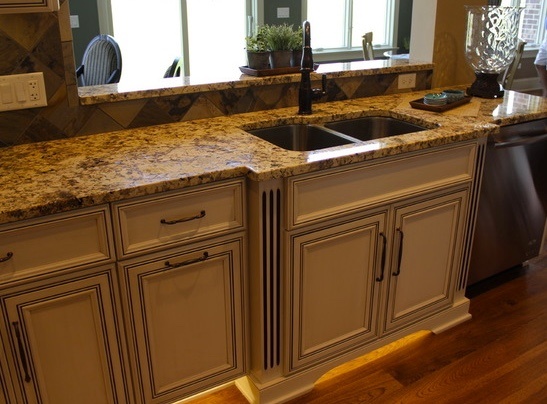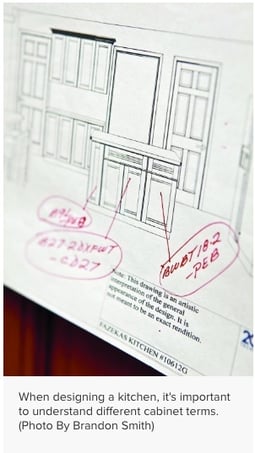
LEARN HOW TO SPEAK THE LANGUAGE OF KITCHEN CABINETS
If you’re thinking about remodeling a kitchen, or you’re already in the process, we can help you understand some of the most important and frequently used terms so you understand what everyone is talking about. This is your quick-access guide to get you started on the things you should know before getting into a kitchen project.
Stock, semi-custom and custom cabinetry
• Stock cabinetry is mass-produced and offers fast lead times, but it has limited sizes and options.
• Semi-custom cabinetry provides more options than stock to choose from, but because it’s made to order, the lead times are longer.
• Custom cabinetry means unlimited options and usually best quality, with typically the longest lead times.
Cabinet door styles
Door style is the visual appearance of the cabinet door’s front. The door style you choose will dictate your kitchen or bathroom’s style. It’s a foundational choice in determining the theme of your kitchen. Typical door styles include:
• Raised panel: This door style has a decorative wood panel with a raised center surrounded by a wood frame. The shape of the interior can vary. These work well with more expensive, traditional style kitchens
 • Reversed raised panel: It is a combination of both a raised panel and flat panel door style. The center part of the panel is reversed, so what is typically the backside of the center panel is on the outside and the raised panel is on the inside of the cabinet. It looks similar to a Shaker door style with the exception of the interior of the kitchen cabinet door.
• Reversed raised panel: It is a combination of both a raised panel and flat panel door style. The center part of the panel is reversed, so what is typically the backside of the center panel is on the outside and the raised panel is on the inside of the cabinet. It looks similar to a Shaker door style with the exception of the interior of the kitchen cabinet door.
• Recessed panel: A solid wood frame surrounds the center panel. It typically costs less than other door styles.
• Shaker: This door gets its name from the Shaker furniture style. Also referred to as a panel cabinet, it is known as a flat panel or recessed panel door style. Four pieces of wood frame its flat center. Its cost and simple clean lines make it one of the most popular door styles. Due to its versatility, it goes well with traditional, transitional and contemporary style kitchens.
• Mullion: This unique door style comes without center panels and sometimes has a gridded center or design. They are typically used as an accent that’s intended to have a glass door insert.
• Slab: This door style is made from one slab and has no frame. It is popular in modern and contemporary kitchens. It is ideal for the minimalist and usually features a laminate or thermofoil coating over the wood.
Door styles can come in square, arched or cathedral frames.
Cabinet construction materials
Manufacturers use a variety of materials to construct cabinets, including:
• Solid wood: Solid wood cabinets use one piece of wood for each piece. You may see variations in the wood grain where multiple pieces join together.
• Medium-density fiberboard (MDF): An engineered wood product, MDF is made of wood fibers that are joined together with an adhesive.
• Particle board: Created from wood chips and particles that have been pressed together and bonded with an adhesive, particle board is a very common product in the cabinet industry.
• Plywood: Plywood is another engineered wood product on the market, and it is created by combining thin layers of wood together. More expensive than MDF or particleboard, plywood is commonly used in shelving, cabinet box construction and doors.
• Laminate: Known as a countertop material, laminate often serves as a covering on cabinets.
• Melamine: Much like laminate, melamine is a plastic-like product that covers cabinets.
• Thermofoil: Another cover for cabinets made of engineered wood products, thermofoil is a vinyl film that covers doors, boxes and drawer fronts.
Framed vs. frameless cabinets
Cabinets can either be framed, meaning you can see the frame of the cabinet around the door, or frameless, which means the door covers the entire face of the cabinet so all you see is the door.
With frameless cabinets, there is no center stile, the piece of the cabinet face that sits between the doors. So when you open the doors, it’s all shelving with nothing in the way.
With framed cabinets, there are varying degrees of overlay, including:
• Full overlay: The door covers the entire face of the cabinet, so all you see is the door.
• Partial overlay: This is between full and standard overlay, so some of the face frame is visible.
• Inset: This is where the door sits flush with the face frame of the cabinet, so the entire face of the cabinet is at the same level.
Finishing options for kitchen cabinets
Finish: The finish is the stain or paint that the cabinet is finished with. Multitudes of color options exist.
• Glaze: In addition to finish, you can add a dimension of color with a glaze color that goes on top of the regular finish.
• Distressing: Distressing is a result of using methods of finish or actually slightly damaging the finish of a cabinet to make it look aged, or like an antique.
Soft-close cabinet doors and drawers
If your doors and drawers slam shut loudly, you do not have soft-close hinges or drawer slides. Soft-close hardware catches doors and drawers before they hit and slows them down to close smoothly and quietly.
More cabinet terms to learn
For an in-depth list of cabinet terms click below.
This article was originally posted on Angie's List. Chad Kurtz President of Brakur Custom Cabinetry is a regular contributor to their Experts Contributor Program.

